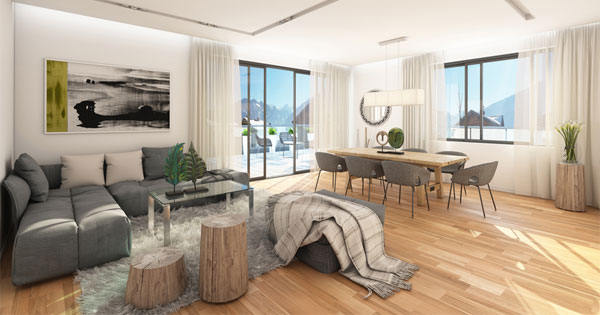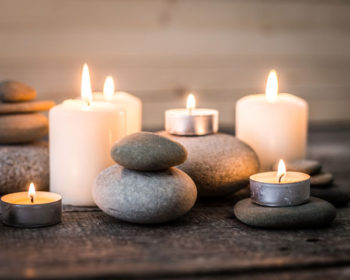Decor expert, Chrissie Rucker has a style that’s both elegant and beautiful. Follow her simple ideas on how to make your home a calm, happy place.
ALSO SEE: Decluttering tips for your tech life
Pile on the texture
Touch, the most instinctive and physical of all the senses, holds the key to comfort and relaxation in the home. Think about the texture of every aspect of your living space, from the floors to the furnishings.

Choose textures you feel in tune with. Natural materials, such as weathered wood, slubby linen or marble slate will always touch us more than the artificial. A synthetic blanket might look good, but it can never emulate the cosy opulence of pure cashmere or soft wool. Mix different textures together to bring out the contrasts: waffle knits with cables, taffetas with silks, coarse hessian with smooth velvet.
Put flowers on display
If you do nothing else in your home, bring in some fresh flowers. They connect us back to nature and inject life, colour, scent and sensuality into even the blandest of spaces.
Avoid intricate arrangements. Choose blooms you love and don’t feel you need to spend a lot of money. Just a few expensive flowers can be beefed up with greenery from the garden to give a fantastic result.
Best blooms for year-round white:
- Baby’s breath Pretty, but scentless. Used as a filler, but dramatic on its own.
- Daisy A bunch of wild flowers looks pretty in the kitchen.
- Orchid For a simple but dramatic display.
- Rose Always beautiful and hard to beat.
- Stephanotis A pretty, star-shaped jasmine.
Create a stylish sitting room
Keep it seasonal
Just as we change our clothes according to the season, so we should change those in our home. Simply by switching textures, fabrics and accessories, you can easily alter the atmosphere of a room.
Cool summer
In warmer months, use lightweight fabrics in white or pastel colours. Add interest by varying the textures: waffle cotton against slubby linen; ribs alongside softer weaves.
Warm winter
Bring in the warmth during autumn and winter, opt for thicker textures and deeper colours. Wool, mohair, cashmere and velvet will all add instant cosiness and can be layered on top of each other to up the comfort factor.
Add a personal touch
Even the most beautifully decorated home won’t be atmospheric unless there’s a good dose of you in it. The loveliest, most soulful spaces are those that tell us stories about the people who live in them. Places with personality can’t help but feel warm, personable and inviting.
The most obvious and easy way to add a personal touch to a room is to bring in photographs. If you don’t want to display them on the wall, invest in a few beautiful frames and create a collection on a mantelpiece or tabletop. For a more informal effect, pin a collection of favourites to a noticeboard – the bonus of this is that you can change them whenever you like.

Try the power of scent
Smell can activate instant emotions and trigger long-forgotten memories. That’s why a house filled with familiar and comforting aromas will make us feel instantly at home. Scenting the home is incredibly easy. For an instant scent fix, bring in a bunch of seasonal flowers; for a more consistent perfume, go for room diffusers, potpourri, scented candles or sprays. Getting the right level of scent in a room requires a bit of trial and error. I find using a diffuser in the sitting room provides the perfect light scent around the house for daytime. When night falls, I boost scent levels by lighting one or two scented candles in each room.
Use colour for contrast
In a predominantly white room, a splash of intense colour can work brilliantly. Deep and moody natural colours such as olive, aubergine and midnight blue will add depth to a room. For a strong but simple scheme, pick two key colours and use them for fabrics and accessories. By restricting the use of colour to smaller, portable bits and pieces, you can easily alter the look of your room.
How to make it work:
- Keep things simple by just using two colours that complement each other.
- Make colours work with the seasons.
- Colour can come from anything – a throw, picture, lampshade, vase or flower.
ALSO SEE: How to clean the dirtiest spots in your bathroom

